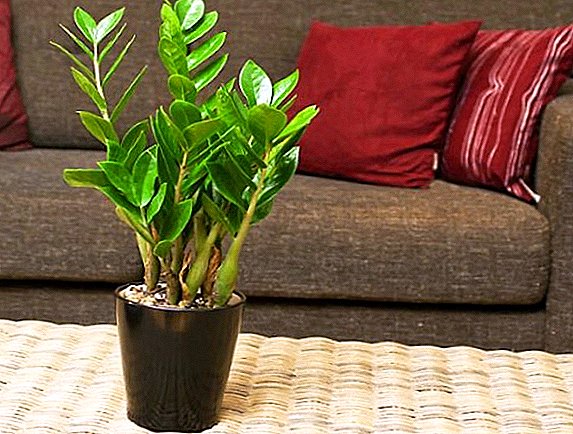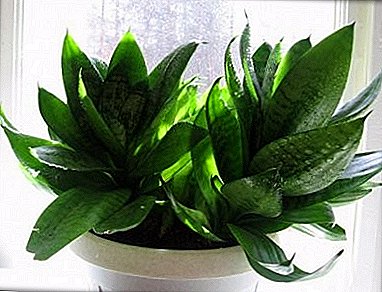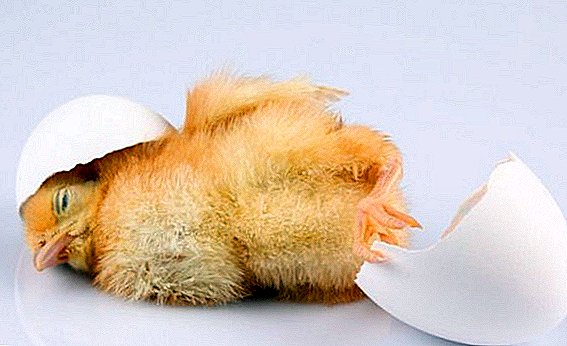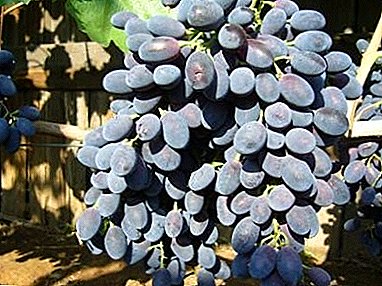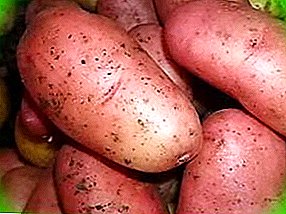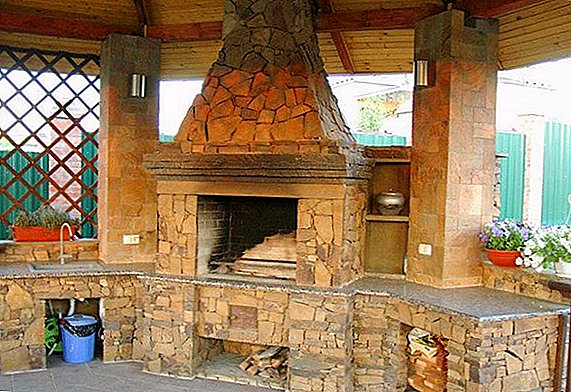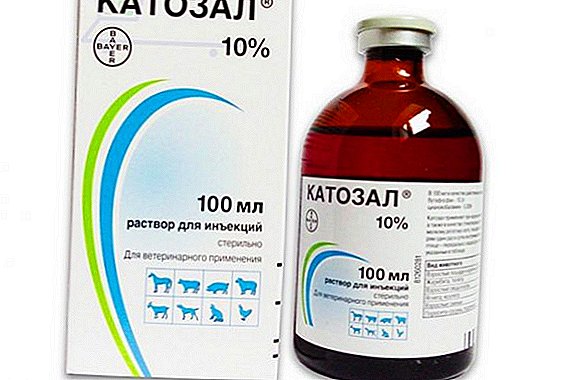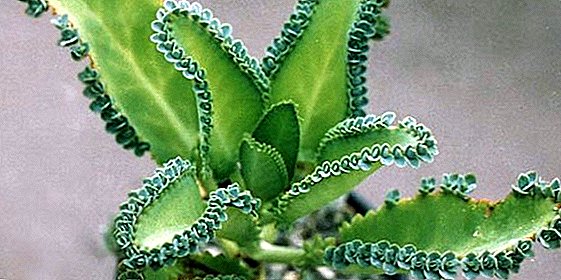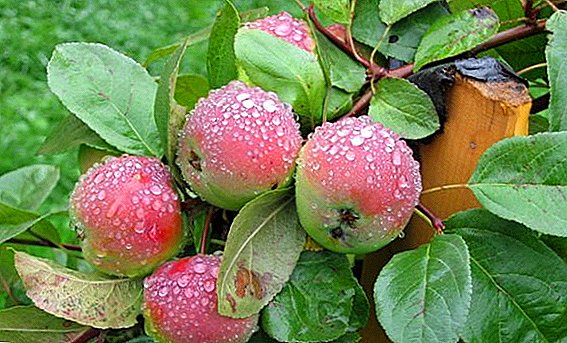 Each owner on the site grows one or another sort of apple, which is the successful work of breeders. Each variety has its positive aspects, it is adapted to a particular climate and soil, therefore, it is impossible to single out the most popular one that is planted throughout the country. We describe in detail the winter variety of apple Krasa Sverdlovsk, discuss the most important points related to planting and cultivation. Let us find out what this variety is unique for, and for which farms it is best suited.
Each owner on the site grows one or another sort of apple, which is the successful work of breeders. Each variety has its positive aspects, it is adapted to a particular climate and soil, therefore, it is impossible to single out the most popular one that is planted throughout the country. We describe in detail the winter variety of apple Krasa Sverdlovsk, discuss the most important points related to planting and cultivation. Let us find out what this variety is unique for, and for which farms it is best suited.
Breeding history
The variety got its name in honor of the Sverdlovsk Experimental Station, where the scientists Kotov, Vengerova and Dibrova developed them on the basis of large-fruited apple varieties.  The variety is promising for the central regions of Russia, the Southern Urals and the Volga region. It is worth noting that with the stanzevian method of cultivation, this variety bears fruit excellently on the territory of Western Siberia and in Altai.
The variety is promising for the central regions of Russia, the Southern Urals and the Volga region. It is worth noting that with the stanzevian method of cultivation, this variety bears fruit excellently on the territory of Western Siberia and in Altai.
Important! The shanty growing method implies a gradual tilting of the tree during its growth. The tree is tilted to the north, so that the above-ground part and the ground warmed better under the sun, whose rays in this latitude fall at a small angle. The vertical position of the tree will not allow it to receive a sufficient amount of light and heat.
Biological features
We begin the discussion of the apple Krasa Sverdlovsk with a detailed description of all the parameters and photos of the tree.
Tree description
The apple tree is medium sized and has a dense round crown. The main branches grow almost at right angles. The bark is colored dark brown.  Fruits form on short and long rods, as well as on branched rings. The sheet plates are painted in dark green, have a heart shape at the base. The buds are quite large, wide-bell, painted white with a pink tinge.
Fruits form on short and long rods, as well as on branched rings. The sheet plates are painted in dark green, have a heart shape at the base. The buds are quite large, wide-bell, painted white with a pink tinge.
Check out also other varieties of apple trees: "Uralets", "Imrus", "Champion", "Melba", "Uslada", "Candy", "Northern Sinap", "Sun", "Currency", "Berkutovskoe", "Sinap" Orlovsky, Dream, Zhigulevskoe.
Fruit Description
Fruits are medium sized or slightly larger than average. The weight of one fruit is 180-200 g, depending on the age of the tree and the availability of essential nutrients.
Apples have a regular rounded shape and smooth skin. At harvest, the fruits are colored greenish-yellow with a characteristic red side. During storage, they acquire a light orange color, the red spot remains.  The flesh of apples is dense, has a sweet-sour pleasant taste. As for the chemical composition, it is worth noting the high content of ascorbic acid. 100 g of ripe fruit contains not less than 30 mg of vitamin C.
The flesh of apples is dense, has a sweet-sour pleasant taste. As for the chemical composition, it is worth noting the high content of ascorbic acid. 100 g of ripe fruit contains not less than 30 mg of vitamin C.
Important! Apple tree begins to bear fruit only for 6-7 years after planting.
Pollination
If the variety Krasa Sverdlovskaya is your first apple tree on the plot, then you should take into account the fact that the tree is self-fruitless.
That is, the Krasa Sverdlovsk apple tree needs a pollinator, and if other varieties of apple trees do not grow on the site, then pollination will not occur and, accordingly, there will be no ovaries and fruits. For this reason, other varieties are planted next to this variety, which will pollinate our darling.
Important! Other varieties must fit the climate of your region.
Gestation period
The apple tree begins to bloom in May, and ripe fruits are harvested from mid-September to the end of October. Such a time interval arises for the reason that for transportation and further sale the crop is harvested earlier than for personal use.  It should be understood that fruits that were harvested earlier are better suited for long-term storage (they can also be put on ripening), however in such fruits there are slightly fewer nutrients than in fully ripened apples.
It should be understood that fruits that were harvested earlier are better suited for long-term storage (they can also be put on ripening), however in such fruits there are slightly fewer nutrients than in fully ripened apples.
Yield
Another positive side of the variety is high yield. On average, one mature tree gives about 80-90 kg of good quality products.  If we take other indicators, we get 120-180 c per hectare using the optimal planting scheme.
If we take other indicators, we get 120-180 c per hectare using the optimal planting scheme.
Transportability and storage
Harvest is suitable for long-term transportation and not less long-term storage (more than 200 days) in acceptable conditions.
That is, apples collected in October will not lose their presentation until the beginning of May of the next year. Also, the amount of vitamins and minerals remains virtually unchanged.  Good transportability and the possibility of long-term storage led to the use of the variety for cultivation in farmers' cooperatives, which was achieved by the breeders.
Good transportability and the possibility of long-term storage led to the use of the variety for cultivation in farmers' cooperatives, which was achieved by the breeders.
Winter hardiness
At the beginning of the article we talked about the areas in which the variety under discussion can be grown. The zoning, of course, is connected precisely with the winter hardiness of the culture, which we will talk about.
If you want to enjoy the harvest of apples in the winter - try to save them using the method of freezing.Beauty Sverdlovsk can withstand temperatures down to 30˚ С, depending on the humidity of the air. However, it should be remembered that the landing area is strongly influenced by the landing site, since at elevations the air temperature is much higher than in the lowlands.
 When grown in Western Siberia and Altai, one cannot do without good insulation, since the extremely low temperatures for this variety will destroy even the strongest tree. At best, you get rid of the lack of harvest.
When grown in Western Siberia and Altai, one cannot do without good insulation, since the extremely low temperatures for this variety will destroy even the strongest tree. At best, you get rid of the lack of harvest.Did you know? The most expensive apples in the world are grown in Japan. The cost of one fruit starts from $ 21. This cost is due to hand pollination, which is carried out with special sticks. Also, Sekaiichi apples are among the largest and most delicious in the world, because in the process of fruit ripening, the tree is poured with sweet water and honey.
Disease and Pest Resistance
Apple tree Krasa Sverdlovsk, according to reviews of private farms and farmers' cooperatives, has good resistance to pests, which, first of all, is due to the climatic zones in which it is grown.  Scab. Fungal disease, which manifests itself in the form of peeling of the skin, various ulcers on the fruit, greenish-brown spots on the back of the sheet.
Scab. Fungal disease, which manifests itself in the form of peeling of the skin, various ulcers on the fruit, greenish-brown spots on the back of the sheet.
Important! Scab not only reduces the productivity of the tree, but also makes the fruit unfit for sale and for human consumption.For treatment, it is better to use less toxic drugs based on bacteria that actively destroy the fungus. These include all drugs based on the bacterium Bacillus subtilis (Gamar, Fitosporin, as well as their analogues).
If you have not found any bacterial preparations, then you can ask for help from a proven Bordeaux mixture or copper sulphate, which treat affected trees about 7 times per season.
Mealy dew. A common disease caused by a fungus. Symptoms of a lesion are the same in all cultures: leaves, shoots and fruits are covered with a whitish bloom, which is the mycelium of the fungus.  After a spore ripens, a kind of dew is formed on top of the mycelium. Without proper treatment, the leaves fall off, the fruits crack and rot.
After a spore ripens, a kind of dew is formed on top of the mycelium. Without proper treatment, the leaves fall off, the fruits crack and rot.
A completely affected tree is covered in dots and does not bear fruit the following year. Mealy dew loves waterlogged terrain, on which there is a rapid development of the fungus. Lack of moisture slows the spread of the fungus.
It will be useful for you to learn how to save your apple tree from pests.For the treatment, you can use the same bacteria-based drugs. Bacillus subtilis. In this case, you will provide protection against most fungal diseases.
To destroy the fungus using these fungicides: Topaz, Fundazol, Vitaros, Acrobat MC.
Application
The fruits have universal use. Suitable for fresh consumption and for processing (preservation, juice production, drying, etc.).  A high concentration of vitamin C is reduced by several times during the heat treatment process, so fresh fruits and freshly squeezed juices that have not undergone the pasteurization process are of great value.
A high concentration of vitamin C is reduced by several times during the heat treatment process, so fresh fruits and freshly squeezed juices that have not undergone the pasteurization process are of great value.
Rules for planting apple seedlings
Having learned all the details about what constitutes the apple tree Krasa Sverdlovsk, we turn to planting and caring for a tree. Let's start with the proper landing of the young sapling.
Optimal timing
Landing is carried out both in autumn and spring. It is best to plant young trees in the fall, however, if you live in a cold climate zone and there is a fear that the seedling will freeze, then it is better to postpone the planting in the spring.  It is impossible to be late with planting, therefore, if you decide to plant in the fall, then it should be done immediately after the leaves fall. If in the spring - before bud break.
It is impossible to be late with planting, therefore, if you decide to plant in the fall, then it should be done immediately after the leaves fall. If in the spring - before bud break.
Choosing a place
As mentioned above, the tree should be planted solely on a hill for several reasons:
- moisture does not stagnate even in case of prolonged rains;
- during severe frosts, the temperature at higher elevations is always higher;
- on a hill, an apple tree will receive more sunlight and heat.
 It is also necessary to choose a hill for the reason that high occurrence of groundwater is not allowed. Groundwater should be at least 1.5 meters deep from the surface.
It is also necessary to choose a hill for the reason that high occurrence of groundwater is not allowed. Groundwater should be at least 1.5 meters deep from the surface.It is also not recommended to plant an apple tree at the place where the fruit tree had previously grown. The soil will be depleted, and you will need to make a huge amount of humus and mineral water.
Stepwise landing process
Begin landing with digging holes. The action is carried out a week before the intended landing. The depth and diameter must correspond to the root system, or you can adjust them to standard dimensions (60 cm in depth and up to a meter in width). 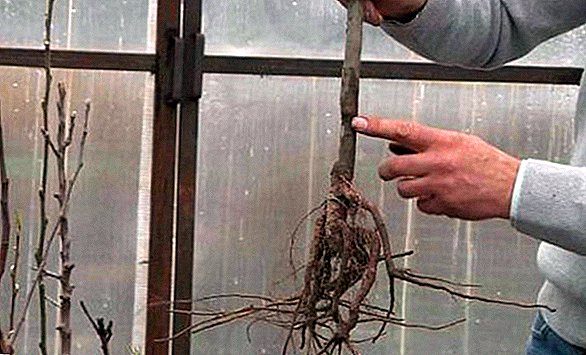 During the digging of the pit, it is necessary to separate the upper layer, since it contains a greater percentage of humus in the composition. The bottom layer is useless for us, so it can be removed to another place.
During the digging of the pit, it is necessary to separate the upper layer, since it contains a greater percentage of humus in the composition. The bottom layer is useless for us, so it can be removed to another place.
Soak roots in water at room temperature before planting. After soaking, inspect the roots, remove the damaged and dry to healthy tissue.
Next, make a suitable soil mixture. To do this, we mix the top layer of soil, which we took when digging a hole, with superphosphate (about 250-300 g), potassium chloride (50 g) and wood ash (0.5 kg). After that, add to the mixture the organic matter - humus (at least 15 kg).  Before planting the seedling, we fall asleep to 2/3 of the pit with prepared soil mixture, lightly press it, and then immerse the seedling so that the root neck protrudes 5-6 cm above the ground. After that, set the peg next to it, to which the tree is tied. We pour out the remnants of a fertile mixture and lightly tamp.
Before planting the seedling, we fall asleep to 2/3 of the pit with prepared soil mixture, lightly press it, and then immerse the seedling so that the root neck protrudes 5-6 cm above the ground. After that, set the peg next to it, to which the tree is tied. We pour out the remnants of a fertile mixture and lightly tamp.
Important! After the seedling is immersed in the hole, its roots need to be straightened so that they absorb substances from the maximum area.After planting, we dig a small hole in the near-stem circle and pour in up to 40 liters of water (depending on soil moisture).
It is also recommended to mulch the stem to avoid overheating or overcooling of the root system. In the form of mulch suitable straw, sawdust or dry leaves. In case you are going to plant several trees at once in a row method, then you should follow the 3.5 x 2 m planting scheme. The rows form from north to south.
Seasonal care features
At the planting of apple trees, everything does not end, since obtaining a good harvest takes time to care for the soil and the tree itself.
Soil care
Above, we wrote about the fact that after planting a sapling, it is desirable to carry out mulching. Such an action will save you from most of the problems, as the mulch does not allow weeds to grow, protects the roots from strong temperature drops, retains moisture.  You need to grind the near-stem circle with a radius of up to 1.5 m. The thickness of the mulch layer must be at least 4-5 cm.
You need to grind the near-stem circle with a radius of up to 1.5 m. The thickness of the mulch layer must be at least 4-5 cm.
If you refused to mulch, then you need to constantly monitor the soil moisture, conducting irrigation in the tree trunks. You need to pour in the amount of water that corresponds to the size of the tree.
A one-year sapling requires at least 20 liters of water once a week, but in extreme heat the amount of watering increases. Biennial tree is not so much in need of watering, because the root system itself can extract moisture in the soil.
But in a strong heat, you still have to “refresh” a tree with 20-30 liters of water. Apple trees from 3 to 15 years old are watered only in the heat or during the ripening of the fruit.  The frequency of weeding depends on the growth rate of the weeds. If the plot is clean enough, then there is no great need for weeding.
The frequency of weeding depends on the growth rate of the weeds. If the plot is clean enough, then there is no great need for weeding.
Loosening the soil is best done early in the morning or after sunset in the summer or late spring. Loosening allows you to remove the crust from the top of the soil, to give access to the roots to oxygen.
However, it should be remembered that after loosening, there is an increased evaporation of moisture from the soil, so this procedure should not be carried out too often.
Did you know? The top most popular apple varieties that are grown in central Russia include Bulk White, Melba, Arkadik, Mantet, Shtripel, Oryol Striped and Antonovka ordinary.
Fertilization
This is quite an important part of caring for an apple tree, which provides an increase in yield and strengthens the immunity of the tree.
The first fertilization is carried out in the spring, when the first leaves appear on the apple tree.  For a set of green mass, the tree requires a large amount of nitrogen, therefore, we will make it the nitrogen-containing "mineral water".
For a set of green mass, the tree requires a large amount of nitrogen, therefore, we will make it the nitrogen-containing "mineral water".
We perform root dressing, adding 30–40 g of urea or ammonium nitrate to the near-stem circle of 0.5-0.6 kg (nitroammofoska can also be used).
We carry out the second top dressing at the beginning of flowering. We will use flavoring substances that dissolve in water. There are several options (per 10 liters of water):
- superphosphate (100g);
- slurry (1/2 bucket);
- urea (300 ml).
Important! Liquid fertilizers are applied only during dry hikes. If it rains, then close the dry analog.The third feeding is made during the mass gain by the fruits. There are 2 popular options:
- A mixture of nitrophosphate (500 g) and sodium humate (10 g), diluted in water (100 l). Under each tree we pour in 30 l.
- Green fertilizer diluted in water in a ratio of 1:10. Fertilizer is made as follows: greens are poured into a large container, poured with water, covered with film and fermented (about 20 days). Pre-film need to make a few holes.
Prevention of diseases and pests
Earlier we said that this apple variety has a very high resistance to pests and is affected only by certain diseases.
However, even high resistance does not negate the preventive measures that must be carried out in order to keep trees healthy.  Against sucking pests (aphids, spider mites and others), you can plant phytoncide plants that scare away uninvited guests.
Against sucking pests (aphids, spider mites and others), you can plant phytoncide plants that scare away uninvited guests.
Most pests that infect an apple tree are handled by chemicals. For insect control, any insecticides are suitable, which should be used strictly according to the instructions.
Since an apple tree can attack several types of insect pests at once, then there is no point in wasting time destroying each one individually.
It is for this reason that it is better to purchase a broad spectrum insecticide, which will destroy all the parasites at once.  In order for the apple tree to suffer less from various pests and diseases, you need to take care of its immunity. To this end, it is necessary to carry out timely watering, remove dry and rotten parts of the plant, destroy weeds in the area and carry out proper preparation for wintering.
In order for the apple tree to suffer less from various pests and diseases, you need to take care of its immunity. To this end, it is necessary to carry out timely watering, remove dry and rotten parts of the plant, destroy weeds in the area and carry out proper preparation for wintering.
Quite often there is a problem when small leaves form on a tree. The problem can be solved biologically by planting alfalfa or other legumes on the plot.
These herbs consume a minimum of zinc, and the phosphorus consumed by them eventually translates into biological readily available phosphates. 
Cropping and crown formation
In addition to climatic features, soil fertility and the presence of the necessary minerals, the quantity of products is strongly influenced by the correct pruning of the branches and the formation of the crown.
The first pruning is done when the tree is 2 years old. In early spring, before the buds swell, you need to pin a growth point so that the tree forms lateral shoots.  Then every year every spring you need to cut last year's shoots by a third, so that fruit branches are formed on them.
Then every year every spring you need to cut last year's shoots by a third, so that fruit branches are formed on them.
As a result, the crown of the tree should resemble the shape of a ball. The crown should not be "flat", but extended upward also does not fit.
Learn all about correct pruning of apple trees in spring and autumn.The important point is the thinning of fruit ovaries. This procedure allows you to get larger apples that will get more nutrients. From each inflorescence to cut the middle fruit. Also, all deformed, damaged or too small apples are subject to removal.
Preparing for the winter
На заключительном этапе мы поговорим о подготовке нашей яблони к зимовке. This is a rather complicated case in the first year of life, but with subsequent years, small missteps in terms of insulation will not harm the strengthened tree.
The trunk of the tree must be warmed with burlap or thick cardboard, which is attached to the trunk. It is necessary to arrange the insulation so that its bottom touches the ground, and the top reaches the first lower branches.  On the radical circle lay a layer of large sawdust, dry leaves or grass. If you use a non-natural insulation, then make sure that it is hydrophobic, that is, it does not accumulate moisture.
On the radical circle lay a layer of large sawdust, dry leaves or grass. If you use a non-natural insulation, then make sure that it is hydrophobic, that is, it does not accumulate moisture.
As soon as the first snow falls, at once we rake it under the tree, covering the preliminary laying. The optimum layer of snow, which will save the tree from the severe frosts, is 1 m.
For warming seedlings, it is better to use thick agrofibre, which is carefully wrapped around the radical neck. The rest of the above-ground part is tied with thick white paper.  After this we make an earthen mound, covering the tree for 30-35 cm with earth. As soon as the first snow falls, we will shelter the rest of the seedling.
After this we make an earthen mound, covering the tree for 30-35 cm with earth. As soon as the first snow falls, we will shelter the rest of the seedling.
This concludes a detailed analysis of planting and caring for an apple Krasa Sverdlovsk. The variety is quite successful, has a huge number of positives, however, there are drawbacks that are expressed by poor winter hardiness and fruiting only for 6 years after planting.
In order to neutralize all negative aspects, you need to follow our instructions and use toxic chemicals only as a last resort.


